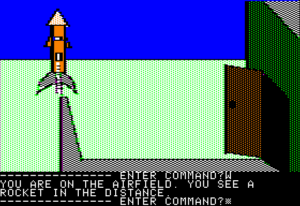Mission Asteroid
 OK, let’s play something historical. Let’s get way on back. There are ten games in the Stack from before 1990. Three of them are Apple II games from Sierra, as re-released in the 1997 Roberta Williams Anthology. Today, I play the oldest: Mission Asteroid, Sierra’s “High-Res Adventure #0”. 1Actually the third released in the series, after Mystery House and The Wizard and the Princess, both of which are already off the Stack.
OK, let’s play something historical. Let’s get way on back. There are ten games in the Stack from before 1990. Three of them are Apple II games from Sierra, as re-released in the 1997 Roberta Williams Anthology. Today, I play the oldest: Mission Asteroid, Sierra’s “High-Res Adventure #0”. 1Actually the third released in the series, after Mystery House and The Wizard and the Princess, both of which are already off the Stack.
The story of Mission Asteroid is basically the same story as Michael Bay’s Armageddon, but without the complexity. There’s an asteroid on a collision course with Earth, so you go up in a rocketship and blow it up with a bomb. That’s it. That’s pretty much the entire game right there. It was meant as a simple introductory adventure for beginners, and simple it is. Most of the game consists of following instructions and using things for their intended purpose. There’s one bit requiring a small leap of intuition at the very end, and I was briefly stuck on guessing the command to get through a door in the very beginning, but for the most part, the only serious obstacles are time limits: there’s an overall limit on the number of turns you can take before asteroid impact, and a smaller restriction on the air supply in your spacesuit.
Overall, it’s amateurish by today’s standards, more like what I’d expect from sample code for an adventure engine than a work you’d release on its own merits. It seems a little ungracious to pick on a game written under the technical limitations of the Apple II, but some games age better than others, and the ones that hold up the worst are those, like this one, based primarily on showing off new graphics technlogy. It’s clear that the authors spent most of their effort on creating the “high-res” 280×192 2The dimensions of the screenshot thumbnailed above are twice this, because that’s how the Apple II emulator included in the Roberta Williams Anthology renders it. illustrations for each room, and the vector-based graphics engine that draws them, stroke by stroke, as you watch. The parser and world model are barely capable of supporting even the minimal story that the game tells, and on three separate occasions resort to special-case disambiguation questions where the two-word parser is inadequate. The same authors would go on to create King’s Quest, another triumph of technology over content.
I note with interest that, even at this early stage, Sierra provided the convenience of toggling graphics by hitting the ‘return’ key on an empty command line, a feature that other illustrated adventure engines would imitate. But here, you can’t turn the graphics off permanently: the graphics come back as soon as the illustration changes, whether because you’ve changed location, or dropped something, or just stood still while the view through the window of your orbiting craft changes.
 Of course, no analysis of a work of asteroid-impact fiction would be complete without criticism of the physics involved. Blowing up an asteroid doesn’t make the matter disappear. It just breaks it into smaller pieces and starts them moving away from each other. If it’s mere hours away from Earth when blown up, as in this game, will the chunks be moving apart fast enough for most of them to miss the Earth entirely? Or will you just wind up “shooting yourself with a shotgun instead of a rifle”, as one astronomer put it? Mission Asteroid takes the pessimistic view here, and I can only assume it does so inadvertently. If you succeed in your mission, you get a “congratulations and thank you for playing” message, but the game doesn’t halt. You can keep on playing if you like, even though there’s nothing left to do. And if you do, the time limit is still active. A few turns after I won, the asteroid impact happened anyway.
Of course, no analysis of a work of asteroid-impact fiction would be complete without criticism of the physics involved. Blowing up an asteroid doesn’t make the matter disappear. It just breaks it into smaller pieces and starts them moving away from each other. If it’s mere hours away from Earth when blown up, as in this game, will the chunks be moving apart fast enough for most of them to miss the Earth entirely? Or will you just wind up “shooting yourself with a shotgun instead of a rifle”, as one astronomer put it? Mission Asteroid takes the pessimistic view here, and I can only assume it does so inadvertently. If you succeed in your mission, you get a “congratulations and thank you for playing” message, but the game doesn’t halt. You can keep on playing if you like, even though there’s nothing left to do. And if you do, the time limit is still active. A few turns after I won, the asteroid impact happened anyway.
| ↑1 | Actually the third released in the series, after Mystery House and The Wizard and the Princess, both of which are already off the Stack. |
|---|---|
| ↑2 | The dimensions of the screenshot thumbnailed above are twice this, because that’s how the Apple II emulator included in the Roberta Williams Anthology renders it. |
 Comments(2)
Comments(2)